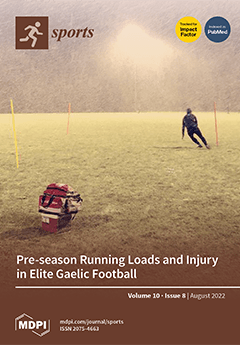The purpose of this study was to examine and compare the training and detraining effects of outdoor serial and integrated combined exercise programs on health, functional capacity, and physical fitness indices. Fifty-one untrained overweight/obese males (47 ± 4 years) were divided into a
[...] Read more.
The purpose of this study was to examine and compare the training and detraining effects of outdoor serial and integrated combined exercise programs on health, functional capacity, and physical fitness indices. Fifty-one untrained overweight/obese males (47 ± 4 years) were divided into a serial combined (SCG), an integrated combined (ICG), or a control (CG) group. The SCG and ICG implemented a 3-month training (3 sessions/week) consisting of walking and body weight exercises. The only difference between SCG and ICG was the sequence of aerobic and strength training. In SCG, the strength training was performed before aerobic training, while in ICG the aerobic and the strength training were alternated repeatedly in a predetermined order. Health, functional capacity, and physical fitness indices were measured before the training, following the termination of programs, and 1-month after training cessation. Following the training, both the SCG and ICG groups showed reduced blood pressure, heart rate, body fat, and waist-to-hip ratio (3–11%;
p < 0.001), with improved respiratory function, muscle strength, aerobic capacity, flexibility, and balance (14–61%;
p < 0.001). After 1-month of training cessation, significant reductions (
p < 0.05) were observed in health indices and physical fitness without returning to baseline levels. However, there were no differences between SCG and ICG after training and training cessation (
p > 0.05). In CG, all the above variables did not change. Furthermore, a great percentage of participants in both exercise groups (90%) reported high levels of enjoyment. In conclusion, both serial and integrated outdoor combined walking and body weight strength training programs are enjoyable and equally effective for improving health, functional capacity, and physical fitness indices in overweight/obese middle-aged males.
Full article






